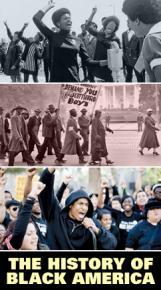The African Blood Brotherhood
explains the rise of the militant Black organization, and how it was influenced by the Russian Revolution.
ONE OF the biggest strike waves in U.S. history swept the country in 1919. But the "Red Summer" of that year also exposed the enormous racial divisions in the American working class. Race riots flared over 25 major cities. At least 500 Blacks died in the violence.
But Blacks resisted these racist attacks more strongly than ever.
As the Black press wrote, a "militant" "New Negro" had emerged through the experience of the First World War. Industrial jobs and their steady wages raised the expectations of the 750,000 Blacks who had moved to the Northern cities during the war. Many of the 300,000 Black war veterans kept their guns and organized armed self-defense against the racist attacks.
The ideas of the "New Negro" were expressed in several Harlem-based Black newspapers, which argued quasi-socialists politics, such as the Messenger, the Emancipator, and the Crusader.
The Crusader was founded in 1918 by the West Indian-born Cyril Briggs. Briggs had lost his job as editor of the Amsterdam News because of his opposition to the war. Briggs dedicated the Crusader to "a renaissance of Negro power and culture throughout the world."
In 1919, the paper became the voice of Briggs' "African Blood Brotherhood (ABB) for African Liberation and Redemption."
The ABB began as a revolutionary Black nationalist organization, calling for the establishment of a separate Black nation within the boundaries of the U.S. "Is it not time to consider a separate political existence with a government that will represent consider and advance us?" Briggs wrote in 1917.
But by late 1919, Briggs looked to socialism, noting support given to national liberation by the early Russian workers' state. He supported a Louisiana strike led by the anti-racist union, the Industrial Workers of the World (IWW), and called on Blacks to make "alliance with the liberal and radical forces of the country--of the world."
Briggs' enthusiasm for the Bolshevik revolution and the IWW did not bridge the gap between the ABB and the pro-Bolshevik left wing of the Socialist Party (SP), a forerunner of the Communist Party. Language barriers made it difficult for the left wing to relate to Blacks and other English-speaking workers--the majority of the left wing was foreign born.
One of Socialist Worker's earliest features was a monthly series on the history of the African American struggle in the U.S., from slavery to the present day.The History of Black America
But the left's political weaknesses were a much bigger problem. The left wing accepted party leader Eugene Debs' declaration that socialists had "nothing special to offer" to Black workers. In other, words, the SP would relate to Blacks only as workers, not as an oppressed minority. In practice, this meant ignoring the struggle against lynchings and racism or the huge Black nationalist movement that exploded after the First World War.
The early Communist Party did not correct this error. By 1920, Jamaican-born Marcus Garvey claimed 500,000 American Blacks for his Universal Negro Improvement Association (UNIA). Garvey's slogans, such as "Up You Mighty Race" and "Back to Africa," attracted many Blacks.
In that same year, the U.S. Communist leader John Reed reported that Blacks "have no demands for national independence...[Blacks] considered themselves first of all Americans at home in the United States."
Reed's ignorance of the Black movement was common among white American Communists of the time. It was only after three years' pressure from the Russian revolutionary Lenin that they acted on Briggs' calls for the left to build alliances with the Black movement. Such an alliance could have developed into a revolutionary socialist presence with the Garvey movement. Instead, the ABB remained isolated from the white revolutionary left, until the early 1920s.
LITTLE IS known about the ABB's day-to-day activities. There was little formal organizational structure--the Crusader required no dues from the Brotherhood's 3,000 to 5,000 members. Its biggest base was in New York and cities such as Chicago and Baltimore. But it also claimed members in Trinidad, Surinam, British Guiana, Santa Domingo and the Windward Islands.
At least some of the ABB's members heeded Briggs' call for armed self-defense against racist attacks. In 1921, the Tulsa, Okla., branch of the ABB vowed to prevent--with violence if necessary--the lynching of a Black man accused of "bothering a white woman." When a lynch mob tried to disarm them, Blacks shot back, killing a white. The governor called in the National Guard and hired a private plane to drop bombs that wiped out several Black neighborhoods.
Initially, the ABB claimed no connection to the Tulsa self-defense group. A few months later, however, the Crusader proudly used the Tulsa episode as a basis of recruitment, asking, "What other organization can claim that brave record?"
That "other organization" alluded to in the question, very likely, was Garvey's UNIA. Briggs believed Garvey's "Back to Africa" strategy was utopian and avoided the question of how to win Black liberation in the U.S.
Briggs had become a revolutionary socialist, joining the Communist Party in 1921. Garvey's vision of Black capitalism was growing more conservative. The two men became bitter enemies, after the ABB tried to pass a resolution calling for Black and white working-class unity at a UNIA conference.
Most of the ABB's Harlem leadership, including the West Indian-born orator Richard B. Moore, followed Briggs into the Communist Party. Like Briggs, they were impressed by the Bolsheviks' support of national liberation struggles and the anti-racist stance of the Russian workers' state.
The political strength of the ABB was its ability to look beyond the racist horrors of 1919 America toward a vision of workers power. The ABB understood the Black struggle could give a powerful impetus to the revolutionary workers movement. The degeneration of the Communist Party and the final dissolution of the ABB will be taken up in the next article in this series.
First published in the September 1985 issue of Socialist Worker.



